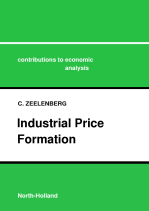 Industrial Price Formation: Summary Part III
Industrial Price Formation: Summary Part III Industrial Price Formation: Summary Part III
Industrial Price Formation: Summary Part IIIPart 3 (Chapters 6-9) deals with price formation under imperfect competition. In most of this part I assume that all producers in an industry act in complete collusion, i.e. they form a monopoly. This assumption makes it possible to concentrate on the influence that foreign competition and competition between industries have on price formation. I also assume that prices of foreign products are exogenous.
I derive in Chapter 6 an equation that relates the price-cost ratio of a monopolist to the ratio of domestic sales and competing imports. The monopolist produces under constant returns to scale a consumer product for which there exists a close foreign substitute; these two products are called two variants of the same good. Consumers allocate their budget in two stages: first they allocate the total budget to goods, and then for each good they allocate the expenditure on it to the domestic and the foreign product. I assume in this chapter that the price elasticity of demand for the good is equal to -1. Application of the theory of two-stage budgeting then gives that the price elasticity of demand is a function of the domestic-sales/competing-imports ratio; because the price-cost ratio of a monopolist depends on the price elasticity of demand, the relation between price-cost ratio and domestic-sales/competing-imports ratio then follows. The coefficient of the domestic-sales/competing-imports ratio must be positive and is an increasing function of the elasticity of substitution between the domestic and foreign products; thus the higher the foreign market share is or the more substitutable the domestic and foreign products are, the lower the price-cost ratio is.
A similar foreign competition variable (often the market share of foreign suppliers) appears in many empirical studies on industrial organization; see Esposito and Esposito (1971), Khalilzadeh-Shirazi (1974), Pagoulatos and Sorensen (1976a, 1976b), Hart and Morgan (1977), Jones, Laudadio, and Percy (1977), Caves and Porter (1978), and De Wolf (1981, 1982). Most of these studies contain cross-section regressions with the profit share as the dependent variable and the foreign market share together with market-structure variables (such as concentration ratio and barriers to entry; see below) as independent variables. The empirical results show that foreign competition has had a strong negative influence on the mark-up in the industries Other food, Textiles, and Clothing and leather.
In Chapter 7 the model of Chapter 6 is generalized: the restriction on the price elasticity of demand for the good is now lifted and the demand for goods modeled by means of the Rotterdam system, price formation by a monopolist who produces producer goods or both consumer and producer goods is studied, and the relation between marginal cost, average cost, and capacity utilization is analyzed. This leads to a model where the price of an industry is determined by average variable cost, average fixed cost, capacity utilization, the domestic market share on the consumer market, the domestic market share on the producer market, and the budget and cost shares of the good (i.e. the share that domestic and foreign producers have in respectively consumer expenditure and producer cost). The price equation that results from these extensions is estimated for 24 industries in the Netherlands. The empirical results show that average variable cost is the most important determinant of the domestic price; average fixed cost and the budget/cost share are important in about half of the industries; and capacity utilization and the domestic market share are important in about a third of the industries.
In Chapter 8 I investigate the relationship between market structure and price formation, in particular the relationship between degree of concentration and the mark-up. Theoretical analyses of the relation between market structure and price formation have been made by Saving (1970), Modigliani (1958), and Cowling and Waterson (1976). These models are combined with part of the analysis of Chapter 7 into a model in which the price-cost ratio depends on concentration, barriers to entry, the domestic market share, and the budget/cost share. The empirical results show that there is no relation between concentration and profit margins. I also derive a relation between price, cost, demand (represented by the domestic market share and the budget/cost share), and concentration; it appears from the empirical results that the more concentrated an industry is, the more its price reacts to changes in capacity utilization and the less its price reacts to changes in the budget/cost share.
Chapter 9 deals with the general-equilibrium structure of the model of Chapter 7, i.e. the comparative statics when all transmissions via cost and demand are taken into account. For some two-good cases I show that increases in exogenous primary cost, foreign prices, and income lead to an increase in domestic prices. The empirical analysis for the 24 industries shows that in most industries primary cost and foreign prices are about equally important determinants of price formation.